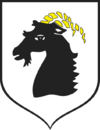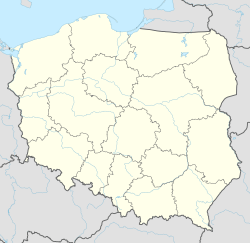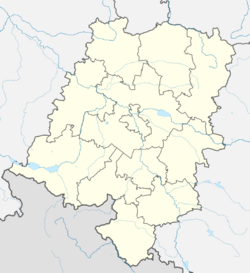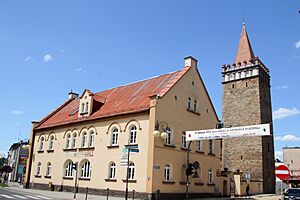Głuchołazy facts for kids
Quick facts for kids
Głuchołazy
|
|||
|---|---|---|---|
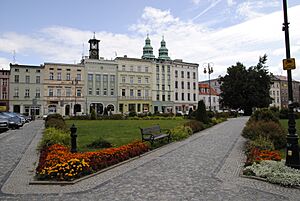
Market Square and Old Town
|
|||
|
|||
| Country | |||
| Voivodeship | Opole | ||
| County | Nysa | ||
| Gmina | Głuchołazy | ||
| Town rights | 13th century | ||
| Area | |||
| • Total | 6.83 km2 (2.64 sq mi) | ||
| Population
(2019-06-30)
|
|||
| • Total | 13,534 | ||
| • Density | 1,981.6/km2 (5,132/sq mi) | ||
| Time zone | UTC+1 (CET) | ||
| • Summer (DST) | UTC+2 (CEST) | ||
| Postal code |
48-340
|
||
| Area code(s) | +48 77 | ||
| Car plates | ONY | ||
| National roads | |||
| Voivodeship roads | |||
Głuchołazy (pronounced Gu-ho-wah-zi) is a historic town in southwestern Poland. About 13,534 people lived there in 2019. It is located in the Nysa County of the Opole Voivodeship (which is like a province). The town is very close to the border with the Czech Republic. Głuchołazy is also the main administrative center for the area called Gmina Głuchołazy.
Contents
Geography of Głuchołazy
This town is found in the historic Lower Silesia region. It sits on the northern slopes of the Opawskie Mountains. The town is nestled in the valley of the Biała River. As of 2019, it had 13,534 residents.
Town Symbol and Name Meaning
Głuchołazy has a special symbol on its shield called a "canting arms." This means the symbol is a picture clue to the town's name. The shield shows a goat's head. This is because the town's old names, like Koziaszyja (Polish), Ziegenhals (German), and Capricolium (Latin), all mean "goat's neck."
Other old Polish names for the town include Cygenhals. People who speak Czech call it Hlucholazy, and those who speak Silesian use Guchołazy.
History of Głuchołazy
The town of Głuchołazy started around the year 1220. It was part of the Duchy of Nysa in Poland. Bishop Wawrzyniec of Wrocław helped establish it. He invited people to settle there and build a strong town. This was to help protect the area from attacks by the Přemyslid family from Moravia.
Głuchołazy was given "town rights" sometime between 1220 and 1249. This meant it could govern itself more. In the mid-13th century, the church of St. Lawrence was built. Its name likely honors Bishop Wawrzyniec, who founded the town.
The town quickly became important for iron ore and gold mining. Later, famous families like the Thurzó and Fugger families managed these mines. By the mid-14th century, defensive walls and a tower were built to protect the town.
In 1428, the town was damaged during the Hussite Wars. In 1445, it became part of the Duchy of Głogówek under a Polish Duke. By 1450, it was back with the Duchy of Nysa. It stayed part of this duchy for many centuries.
The town was also affected during the Thirty Years' War (1618–1648). After the Silesian Wars and a treaty in 1742, Głuchołazy became a border town for Prussia. The nearby area of Zlaté Hory stayed with Austrian Silesia.
In 1834, a big fire damaged the town. In the years that followed, many parts of the old medieval walls were taken down. In the 19th century, Głuchołazy became a popular spa town, known for its healing waters.
During World War II, the Germans set up several forced labor camps in the town. These were subcamps of a larger prisoner-of-war camp. In January 1945, as the war was ending, the people living in Głuchołazy were moved out. A sad event called a "death march" also passed through the town in 1945. Thousands of prisoners from other camps were forced to walk through Głuchołazy. Leon Foksiński, who escaped from this march in Głuchołazy, is now an honorary citizen of the town.
As German forces retreated in May 1945, they blew up bridges. After the war, Głuchołazy became part of Poland. Many German residents left, and Polish people moved in. Many of these new residents came from parts of eastern Poland that were taken by the Soviet Union. Others came from central Poland, especially from the Myszków area. The first mayor of Głuchołazy after the war was Szymon Koszyk, a Polish activist and writer.
The town was also badly affected by floods in 2024.
Sports in Głuchołazy
The local football (soccer) club in Głuchołazy is called GKS Głuchołazy. They play in the lower football leagues.
Famous People from Głuchołazy
- Roland Gumpert (born 1944), an engineer who started the Gumpert sports car company.
- Mieczysław Walkiewicz (born 1949), a politician who was a member of the Polish Sejm.
- Andrzej Sośnierz (born 1951), a politician and doctor.
- Michał Bajor (born 1957), an actor and musician.
- Ewa Chrobak (born 1958), an activist who created the logo for the Order of the Smile.
- Roman Dąbrowski (born 1972), a football player.
- Jakub Ćwiek (born 1982), a fantasy writer.
- Kamil Bortniczuk (born 1983), a politician and former Polish Minister of Sport and Tourism.
- Agnieszka Śnieżek (born 1991), a female basketball player.
Sister Cities
To find out about Głuchołazy's sister cities, you can check the page for Gmina Głuchołazy.
Images for kids
-
Historic tenements (apartment buildings).



